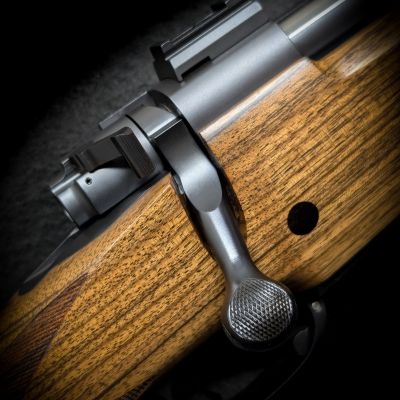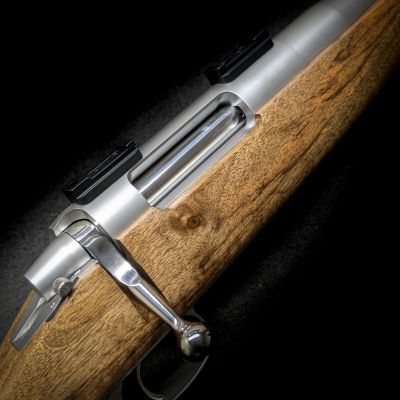Estimated reading time: 15 minutes
Al Exlpains the Key Differences
Key Takeaways
- The choice between controlled round feed vs push feed mechanisms is crucial for rifle reliability.
- Controlled round feed offers positive cartridge control throughout the feeding cycle, enhancing reliability in adverse conditions.
- Push feed mechanisms are simpler and less expensive, providing excellent accuracy potential when properly manufactured.
- Understanding the key differences helps rifle owners select the best option for their specific shooting needs.
- Both systems have proven reliable when well-made; the overall quality of the rifle often matters more than the feed mechanism.
Table of Contents
- What is Controlled Round Feed?
- How Controlled Round Feed Works
- Historical Origins
- Key Characteristics of Controlled Round Feed
- What is Push Feed?
- How Push Feed Operates
- Mechanics and Key Characteristics
- Common Applications
- Controlled Round Feed vs Push Feed: Key Differences
- Feeding Process Comparison
- Extraction Differences
- Manufacturing and Cost Considerations
- Reliability and Performance Factors
- Advantages and Disadvantages
- Ideal Applications
- Benefits of Controlled Round Feed
- Enhanced Reliability in Various Conditions
- Smoother Cycling and Reduced Jams
- Improved Accuracy Through Consistency
- Durability and Longevity
- Easier Unloading and Enhanced Safety
- Historical Preference for Dangerous Game Hunting
- Winchester Model 70 (Pre-1964 and Classic Models)
- Mauser Model 98
- CZ 550
- Ruger M77 Hawkeye
- Controlled Round Feed Hunting Rifles
- Benefits for Hunting Applications
- Popular Hunting Rifles with Controlled Round Feed
- Tips for Selecting the Right Controlled Round Feed Hunting Rifle
- Real-World Performance Considerations
- Quality Matters More Than System Type
- Modern Manufacturing Trends
- Expert Opinions
- Conclusion
- Additional Resources
When selecting a bolt action rifle, understanding the differences between controlled round feed vs push feed mechanisms is crucial for ensuring reliability and performance in the field. These feeding systems determine how a rifle loads, chambers, and extracts cartridges, directly affecting your overall shooting experience.
In this comprehensive guide, we’ll explore both mechanisms in detail, highlighting their differences, benefits, and ideal applications. By the end, you’ll have all the information needed to make an informed decision based on your specific shooting needs.
What is Controlled Round Feed?
Controlled round feed (CRF) is a bolt action mechanism where the extractor claw grips the rim of the cartridge as it’s stripped from the magazine, before the cartridge enters the chamber. This creates a system where the cartridge remains under complete control throughout the entire feeding cycle.
How Controlled Round Feed Works
With a controlled round feed system, the moment a cartridge is lifted from the magazine, the extractor claw captures and controls it. This means wherever the bolt goes, the cartridge follows—creating a reliable feeding path from magazine to chamber and back.
The design offers exceptional reliability because the cartridge never has an opportunity to misalign or jam during the feeding process. The bolt maintains positive control of the round at all times.
Historical Origins
The controlled round feed design has a storied heritage dating back to the late 19th century. The M1885 Remington-Lee rifle, introduced in 1879, was among the first to feature this mechanism, while Mauser perfected and popularized it in their Model 1893.
The Mauser 98 action, with its controlled round feed system, became the gold standard for reliability and has influenced countless rifle designs since its introduction.
Key Characteristics of Controlled Round Feed
- The extractor firmly grips the cartridge rim before it leaves the magazine
- The cartridge remains under positive control throughout the entire feeding cycle
- The system allows for extraction of a cartridge even if it hasn’t been fully chambered
- Enhanced reliability in adverse conditions and awkward shooting positions
- Preferred for applications where absolute feeding reliability is essential
For instance, hunters often rely on rifles like the SD-76 Legend™ Bolt Action Rifle for dangerous game scenarios: https://parkwestarms.com/product/legend/
The controlled round feed mechanism has earned its reputation for dependability in critical situations where a feeding failure is not an option.
https://en.wikipedia.org/wiki/Push_feed_and_controlled_feed
What is Push Feed?
Push feed (PF) is a bolt action mechanism where the bolt face “pushes” the cartridge into the chamber without gripping it during the feeding process. This simpler approach to feeding has become increasingly common in modern rifle designs.
How Push Feed Operates
In a push feed system, the cartridge is stripped from the magazine and pushed forward into the chamber by the bolt face. The extractor doesn’t engage the cartridge until after it has been fully chambered and the bolt has closed.
This design creates a different feeding path compared to controlled round feed, with the cartridge essentially being guided into the chamber by the feed ramps and bolt face pressure rather than being controlled by the extractor.
Mechanics and Key Characteristics
Push feed systems offer several distinctive characteristics:
- Simpler and less expensive to manufacture
- The extractor only engages after the cartridge is fully chambered
- The cartridge is guided rather than controlled during the feeding process
- Often easier to single-load cartridges directly into the chamber
- Clean, smooth feeding when properly designed
Modern manufacturing techniques have allowed push feed systems to achieve remarkable reliability while maintaining cost advantages.
Check out our PW-ACE™ Single Shot Heavy Barrel Rifle here: https://parkwestarms.com/product/pwacehb
Common Applications
Push feed mechanisms dominate in precision shooting competitions like the Precision Rifle Series (PRS), where their inherent accuracy potential is highly valued. Additionally, push feed has been used extensively in bolt action sniper rifles by the US military in recent decades.
The widespread adoption of push feed in high-precision applications demonstrates its capabilities when built to high standards.
https://www.africahunting.com/threads/a-push-feed-rifle-or-a-control-round-feed-rifle.53972/
Controlled Round Feed vs Push Feed: Key Differences
Understanding the key differences between these systems will help you determine which best suits your needs.
Feeding Process Comparison
CRF: The extractor claw grips the cartridge rim as it’s stripped from the magazine, controlling it throughout the feeding process. This creates a guided path with positive control from magazine to chamber.
PF: The bolt face pushes the cartridge forward without gripping it until it’s fully chambered. The cartridge travels somewhat freely during the feeding process, guided by the magazine feed lips and chamber.
Extraction Differences
CRF: Can extract a cartridge at any point during the feeding cycle, even if it hasn’t been fully chambered. This can be advantageous in situations where you need to quickly unload the rifle.
PF: Requires the cartridge to be fully chambered before it can be extracted, as the extractor only engages once the round is seated in the chamber.
Manufacturing and Cost Considerations
CRF: Generally more complex and expensive to manufacture due to more precise engineering requirements and additional machining steps.
PF: Simpler mechanism allows for easier and less expensive manufacturing while maintaining excellent performance.
Reliability and Performance Factors
CRF: Offers enhanced reliability in adverse conditions, making it preferred when absolute reliability is paramount, such as dangerous game hunting.
PF: Has proven reliability in precision shooting and military applications, with excellent accuracy potential when properly manufactured.
Advantages and Disadvantages
CRF Advantages:
- Positive cartridge control throughout feeding cycle
- Can extract unfired cartridges at any point
- Traditional design with proven track record
- Generally more resistant to short-stroking issues
CRF Disadvantages:
- More expensive to manufacture
- May be more difficult to single-load directly into the chamber
- Can be heavier due to additional components
PF Advantages:
- Generally less expensive
- Often lighter weight
- Excellent accuracy potential
- Easier to single-load cartridges
PF Disadvantages:
- Cannot extract unfired cartridges until fully chambered
- Potentially less reliable in extreme conditions
- May have issues with short-stroking
Ideal Applications
CRF: Ideal for hunting dangerous game and situations requiring utmost reliability in adverse conditions. Perfect for rifles that might be used in life-threatening situations.
PF: Well-suited for precision shooting, general hunting, and applications where manufacturing simplicity and cost are important considerations.
https://en.wikipedia.org/wiki/Push_feed_and_controlled_feed
Benefits of Controlled Round Feed
Controlled round feed mechanisms offer several distinct advantages that have kept them popular among certain shooting communities.
Enhanced Reliability in Various Conditions
The positive control over the cartridge reduces the risk of feeding issues, especially when operating the rifle in unusual positions. Whether you’re shooting upside down, sideways, or in awkward hunting positions, the controlled round feed keeps the cartridge on track.
This consistent feeding reliability makes controlled round feed rifles particularly valuable in high-pressure situations where a feeding failure could have serious consequences.
Smoother Cycling and Reduced Jams
The controlled feeding process contributes to smoother overall operation. With the cartridge under positive control, there’s less chance of misalignment during feeding, reducing the potential for jams and feeding failures.
This smooth, controlled cycling is especially noticeable when working the action quickly under stress.
Improved Accuracy Through Consistency
While both systems can be extremely accurate, the reliability of controlled round feed mechanisms enhances accuracy through consistent performance. When you can trust your rifle to feed without hesitation, you can focus on shot placement rather than worrying about potential mechanical issues.
Durability and Longevity
The controlled round feed mechanism features a robust design suitable for rugged use. These systems tend to wear well over time and maintain their reliability even after thousands of cycles.
Easier Unloading and Enhanced Safety
One significant advantage of controlled round feed is the ability to extract a cartridge at any point during the feeding cycle. This enhanced control makes unloading safer and more convenient.
Additionally, controlled round feed won’t jam up when short-stroking the action, providing greater flexibility in operation.
Historical Preference for Dangerous Game Hunting
Hunters pursuing dangerous game have traditionally preferred controlled round feed rifles due to their perceived reliability benefits. When facing potentially life-threatening animals, the ability to clear a malfunction quickly or extract an unfired round can be critical.
https://castboolits.gunloads.com/showthread.php?415611-Push-feed-v-control-round-feed
Controlled Round Feed Hunting Rifles
When it comes to hunting, controlled round feed mechanisms offer specific advantages that many experienced hunters value.
Benefits for Hunting Applications
The reliability of controlled round feed is particularly critical when hunting, especially in these scenarios:
- Dangerous game hunting where a quick follow-up shot may be life-saving
- Hunting in extreme weather conditions where dirt, moisture, or debris might affect feeding
- Situations requiring unusual shooting positions
- When absolute dependability trumps all other considerations
The consistent feeding in various positions and conditions provides peace of mind when in the field, allowing hunters to focus on the hunt rather than worrying about their equipment.
Popular Hunting Rifles with Controlled Round Feed
Several manufacturers have built their reputations on providing reliable controlled round feed hunting rifles:
- Winchester Model 70: A favorite among professional guides and hunters worldwide
- Mauser 98 derivatives: Including many custom rifles built on Mauser actions
- CZ 550: Particularly popular in medium and large calibers for big game
- Ruger M77 Hawkeye: Known for reliability in challenging hunting conditions
- Parkwest Arms Models: Premium controlled round feed rifles for discerning hunters
For an in-depth look at controlled round feed hunting performance, watch Ron Spomer’s review of the SD-76 Bushveld 458 Lott Rifle here: https://parkwestarms.com/ron-spomers-parkwest-arms-sd-76-bushveld-458-lott-rifle-review/
These rifles have proven themselves on hunting expeditions across the globe, from African safaris to North American wilderness hunts.
Tips for Selecting the Right Controlled Round Feed Hunting Rifle
When choosing a controlled round feed hunting rifle, consider these important factors:
Consider Caliber and Intended Game
Select an appropriate caliber for your target game and hunting conditions. Controlled round feed rifles are available in calibers ranging from varmint cartridges to dangerous game stoppers.
Evaluate Action Smoothness
Test the bolt action for smooth operation. A well-made controlled round feed action should cycle smoothly and positively, with the cartridge following the bolt reliably.
Check Build Quality
Look for robust construction and quality materials. Pay particular attention to the extractor, as it’s a critical component in the controlled feed system.
Manufacturer Reputation
Opt for reputable brands known for reliable CRF rifles. Companies with long histories of building these actions have refined their designs over decades.
Personal Fit and Comfort
Ensure the rifle fits well and is comfortable to use. The finest action is worthless if the rifle doesn’t fit you properly or if you can’t shoot it accurately.
Real-World Performance Considerations
When evaluating controlled round feed vs push feed, it’s important to consider real-world performance beyond theoretical advantages.
Quality Matters More Than System Type
Both controlled round feed and push feed can be reliable or unreliable depending on rifle quality and maintenance. A well-made push feed rifle will generally outperform a poorly made controlled round feed rifle.
For many, the overall quality of the rifle can be seen in their extensive selection available online. Explore a wide selection of quality rifles at our store here: https://parkwestarms.com/rifles-for-sale/ or build your own custom dream fifle here: https://parkwestarms.com/product-category/build-your-dream-rifle/
The overall quality of machining, materials, and design has a greater impact on reliability than the type of feeding system alone. Many experienced hunters have used both systems successfully for decades.
Modern Manufacturing Trends
Newer rifles often favor push feed mechanisms due to manufacturing efficiencies and cost considerations. This trend doesn’t necessarily indicate inferior performance but reflects economic realities of modern production.
Despite this trend, controlled round feed remains popular among certain shooting communities and manufacturers who cater to traditional preferences and specialized applications.
Expert Opinions
Many experienced shooters agree that in a quality rifle, either system works well for most applications. As one expert put it, “Either works just fine in a well-made rifle.”
The debate between controlled round feed and push feed enthusiasts continues, but practical experience suggests that for most shooters, either system will provide excellent service when properly designed and maintained.
https://www.luckygunner.com/lounge/controlled-feed-vs-push-feed-rifles/
Conclusion
The controlled round feed vs push feed debate ultimately comes down to specific needs, preferences, and intended use. Both systems have proven their worth in different applications.
Controlled round feed offers enhanced reliability through positive cartridge control, making it ideal for dangerous game hunting and situations where absolute feeding reliability is essential. Its ability to extract cartridges at any point in the feeding cycle provides additional safety and convenience.
Push feed, with its simpler design and manufacturing advantages, delivers excellent accuracy and reliability in a more cost-effective package. Its widespread use in precision shooting and military applications demonstrates its capabilities.
For most shooters, the overall quality of the rifle will matter more than the type of feeding mechanism. A well-made rifle of either type will serve reliably for years, while a poorly made rifle will disappoint regardless of its feeding system.
When choosing between controlled round feed and push feed, assess your requirements, preferences, and intended use carefully. Consider how and where you’ll use the rifle, what type of shooting you’ll do, and what qualities matter most to you as a shooter.
Remember that the best rifle is one that you can shoot accurately, that functions reliably in your conditions, and that gives you confidence in the field—regardless of its feeding mechanism.
Additional Resources
To further your understanding of rifle actions and make the most informed decision possible, consider these additional resources:
Detailed Reviews of the Best Controlled Round Feed Rifles
- Gun Digest’s annual rifle reviews
- American Rifleman’s rifle testing articles
- Field & Stream’s hunting rifle comparisons
- Outdoor Life’s gun tests
Guides on Maintenance and Care
- “Bolt Action Rifles” by Frank de Haas
- “The Bolt Action” by Stuart Otteson
- Manufacturer-specific maintenance guides
- Gunsmithing videos from reputable sources
Further Exploration
The best education comes from hands-on experience. Visit ranges where you can try different rifles, consult with experienced hunters and shooters, and if possible, borrow or rent different rifles before making your purchase.
Remember that theoretical advantages mean little compared to how a rifle performs in your hands under your specific conditions. Take the time to find the right rifle for your needs, and it will serve you well for years to come.



